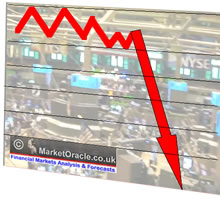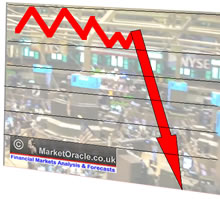Inverse ETFs Let You Profit In a Falling Stock Market
InvestorEducation / Stocks Bear Market Jun 25, 2009 - 12:23 PM GMT Ron Rowland writes: I don’t have to tell you that the stock market can go down as well as up. And the huge volatility we’re seeing in the markets isn’t going away anytime soon.
Ron Rowland writes: I don’t have to tell you that the stock market can go down as well as up. And the huge volatility we’re seeing in the markets isn’t going away anytime soon.
Why not just stay safely in cash then? Well, for some people that’s exactly the right thing to do. For others, however, that might not be the best option.
For instance, maybe a large part of your wealth is tied up in your employer’s retirement plan, which is heavily invested in the company’s stock. You can’t sell it until you retire next year — and you’re concerned that the stock market will fall hard in the meantime.
I have some good news: You can actually protect yourself from losses while making money if the markets plummet!
How to “Short” the Market …
 |
| Without professional guidance, put options are a good way to lose your shirt. |
There are different ways to profit from declines in individual stocks, particular sectors or the major indexes. And the two most common are called short-selling and put options.
In a short sale, you borrow stock you don’t own and sell it. If all goes well, you’ll repay the stock loan when you can buy the shares later at a lower price.
Practically speaking, this isn’t as easy as it sounds …
The stock has to be available for you to borrow, and you must have a margin account. IRAs and other retirement plans aren’t allowed to use margin, so you can’t short stocks within these accounts.
Put options give you the right to sell a stock or an index at a specified “strike price.” Options can be very profitable, but they’re often volatile and illiquid. Moreover, they have time value that decays the longer you hold them.
Options are best for when you have a strong indication of a short-term direction. Otherwise, without professional guidance, they’re a good way to lose your shirt.
Enter Inverse ETFs …
With inverse ETFs you can get around many of the problems of short selling and options trading while potentially “hedging” your long positions. In other words, inverse ETFs can help offset any losses in your regular stock and ETF positions.
So what’s an inverse ETF? It’s just an ETF in reverse …
Remember how in my May 7 Money and Markets column, I told you about SPY: the SPDR Trust that tracks the S&P 500 Index? As I pointed out then, if you’re bullish on stocks you can just buy SPY and your account will go up in tandem with the index.
Well, the ProShares Short S&P 500 can do the same thing if you’re bearish. The ticker symbol is SH, and it tracks SPY in reverse. If the S&P 500 falls 1 percent tomorrow, SH is designed to go up by 1 percent. Nice!
You can do the same thing with other major benchmarks and sectors. Feeling bearish on the Dow? Buy the ProShares Short Dow 30 (DOG). If you think small caps are ready to fall, jump into the ProShares Short Russell 2000 (RWM).
Plus, inverse ETFs have many advantages over short-selling and put options. For example …
- ETFs are much easier to trade. You don’t have to figure out what strike price is best or wonder whether stock is available to borrow. All you need to get started is a standard brokerage account. Plus you can trade inverse ETFs inside your IRA.
- Inverse ETFs have limited loss potential. In a short sale, it’s possible to lose more than your initial investment. Inverse ETFs are designed to prevent this from happening.
- There’s no time value with inverse ETFs. If you have the patience, you can wait months or years for your bet to pay off. Your ETF position won’t expire like options do.
 |
| Inverse ETFs can help you protect your stock investments when the markets go down. |
A word of caution: Inverse ETFs work both ways. If you buy an inverse ETF and the market you’re tracking goes up, your inverse ETF will drop accordingly. So if your timing is even slightly off, you can lose money just as fast as bullish investors are making it.
Another disadvantage of inverse ETFs is that they don’t always track their benchmarks precisely, especially over long time periods.
For example, in 2008 the S&P 500 posted a loss of 36.7 percent. Consequently, you might think that the SH delivered the exact inverse return of 36.7 percent.
Not so. The SH actually gained 39.2 percent. In this case, the tracking error would have been in your favor, but it can go against you, too.
The lesson: If you buy inverse ETFs, make sure you have the right expectations.
There are also inverse ETFs that use leverage. These have additional risk factors you need to understand before purchasing. I’ll cover leveraged ETFs in a future Money and Markets column.
For now, just realize that with inverse ETFs, you don’t have to stay on the sidelines as your stock investments fall in value when the bear starts to growl.
Best wishes,
Ron
This investment news is brought to you by Money and Markets . Money and Markets is a free daily investment newsletter from Martin D. Weiss and Weiss Research analysts offering the latest investing news and financial insights for the stock market, including tips and advice on investing in gold, energy and oil. Dr. Weiss is a leader in the fields of investing, interest rates, financial safety and economic forecasting. To view archives or subscribe, visit http://www.moneyandmarkets.com .
Money and Markets Archive |
© 2005-2022 http://www.MarketOracle.co.uk - The Market Oracle is a FREE Daily Financial Markets Analysis & Forecasting online publication.



